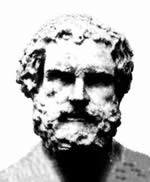| |
Ancient Atomic Theory
 One of the first atomic theorists was Democritus, a Greek philosopher who lived in the fifth century BC. Democritus knew that if a stone was divided in half, the two halves would have essentially the same properties as the whole.Therefore, he reasoned that if the stone were to be continually cut into smaller and smaller pieces then; at some point, there would be a piece which would be so small as to be indivisible. He called these small pieces of matter "atomos," the Greek word for indivisible. Democritus, theorized that atoms were specific to the material which they composed. In addition, Democritus believed that the atoms differed in size and shape, were in constant motion in a void, collided with each other; and during these collisions, could rebound or stick together. Therefore, changes in matter were a result of dissociations or combinations of the atoms as they moved throughout the void. Although Democritus' theory was remarkable, it was rejected by Aristotle, one of the most influential philosophers of Ancient Greece; and the atomic theory was ignored for nearly 2,000 years. One of the first atomic theorists was Democritus, a Greek philosopher who lived in the fifth century BC. Democritus knew that if a stone was divided in half, the two halves would have essentially the same properties as the whole.Therefore, he reasoned that if the stone were to be continually cut into smaller and smaller pieces then; at some point, there would be a piece which would be so small as to be indivisible. He called these small pieces of matter "atomos," the Greek word for indivisible. Democritus, theorized that atoms were specific to the material which they composed. In addition, Democritus believed that the atoms differed in size and shape, were in constant motion in a void, collided with each other; and during these collisions, could rebound or stick together. Therefore, changes in matter were a result of dissociations or combinations of the atoms as they moved throughout the void. Although Democritus' theory was remarkable, it was rejected by Aristotle, one of the most influential philosophers of Ancient Greece; and the atomic theory was ignored for nearly 2,000 years.
|
![]()
